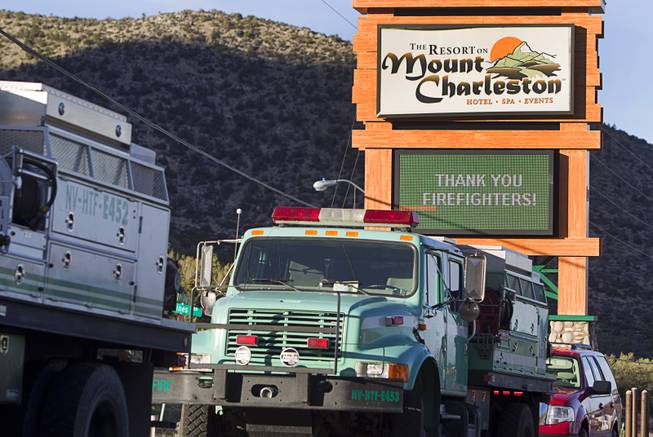
The signboard at the Resort on Mount Charleston posts a “thank you” to firefighters Wednesday, July 31, 2013. The Resort on Mount Charleston hosted a free appreciation dinner for firefighters, law enforcement officers, Red Cross volunteers and Mount Charleston residents to thank everyone involved with fighting the Carpenter 1 wildfire.
Sunday, Aug. 4, 2013 | 2:01 a.m.
View more of the Sun's opinion section
View more of the Sun's opinion section
Editor’s note: Every summer, Brian Greenspun turns over his Where I Stand column to guest writers for several weeks. Today’s writer is Las Vegas Mayor Carolyn Goodman.
For too many days beginning July 2, I looked out of the windows of City Hall at the smoke and clouds roiling over Mount Charleston. They billowed in colors of bright red, orange, black or heavy gray as they were emitted from the Carpenter 1 fire, and daily the sight was more than frightening. At each glance, my thoughts were of firefighters on the mountain putting their lives at risk for us and also, sadly, of those 19 firefighters who perished in June in Yarnell, Ariz. I prayed that all of the firefighters who had come to Nevada to help us were kept out of harm’s way.
That first day, 579 acres burned quickly, but it was only the beginning as the flames spread to more than 27,880 acres, or in excess of 43 square miles (the city of Las Vegas is 135 square miles). It is unfortunate to lose any building, but remarkably, only six were lost and more than 900 buildings were saved. This was an incredible feat, especially when seeing how close the fires came to touching and eradicating so many homes and structures.
The enormity and complexity of the Carpenter 1 fire placed it as the nation’s top-ranking fire, calling for full support and attention, ground and air, from throughout the country. The cost has exceeded $14 million, more than $1 million per day in hard dollar costs.
By Saturday, July 13, I knew it was time to see firsthand what was happening and to try to reach some of the boots-on-the-ground firefighters to let them know personally that we were beyond grateful for their help. So along with the city emergency manager, communications director and a city marshal, we drove to the Carpenter 1 fire area command headquarters. There, Incident Commander Rich Harvey took us through a brief tour of the overall fire management effort at Centennial High School.
The addition of imported mobile shower facilities, supply tents and catering facilities had made the converted high school a home away from home for responders until the fire was out. Personnel were working in each of the support areas (logistics, operations, finance, planning) as well as command staff functions such as liaison, public information and safety.
Representatives of the American Red Cross and other cooperating agencies worked through issue after issue. They worked day and night on building maps, weather forecasting and fire behavior analysis. The staff slept on floors in classrooms, ate donated food and functioned 24/7 as an incredible team.
Then we drove north up U.S. 95 to the mountain, past safety checkpoints and into the burned-out terrain, meandering through roads that were mostly abandoned except for the people and equipment needed to fight the fires.
Teams of firefighters had come in from throughout the country to help us. They came from as far away as Maine, North Carolina and Florida; many were from Colorado, California, Utah, Arizona and New Mexico. At the most experienced level, the teams bear the name “Hotshots” and are made up of 20 members, and a few teams were still in training to become Hotshots. These teams of young people were extremely physically fit, having to carry backpacks weighing 70 to 90 pounds while climbing up rocky terrain.
We met with five of these teams, each of which had just come down to the base for restocking backpack supplies or filling water bags for the next assignment. Most teams spent the nights sleeping on the mountains. Food rations for the day had to amount to more than 6,000 calories per firefighter, for the physical strains could not have been met without such nutrition.
Much of what I saw at the incident command post reminded me of the training I participated in at Emmitsburg, Md., during my first week in office. It is reassuring to know that what we learned in that program is consistent with how the rest of the country is trained and, more importantly, how that training is put into practice when the need arises.
Now that the threat of the fire has subsided, we look toward the future of recovering from the tragic damage to our beloved, though fragile, mountain environment.
The city of Las Vegas thanks all of those who came to our aid — both from the local area and throughout the country — in our time of need and gave help and hope to our community.
Carolyn Goodman is the mayor of Las Vegas.

Join the Discussion:
Check this out for a full explanation of our conversion to the LiveFyre commenting system and instructions on how to sign up for an account.
Full comments policy